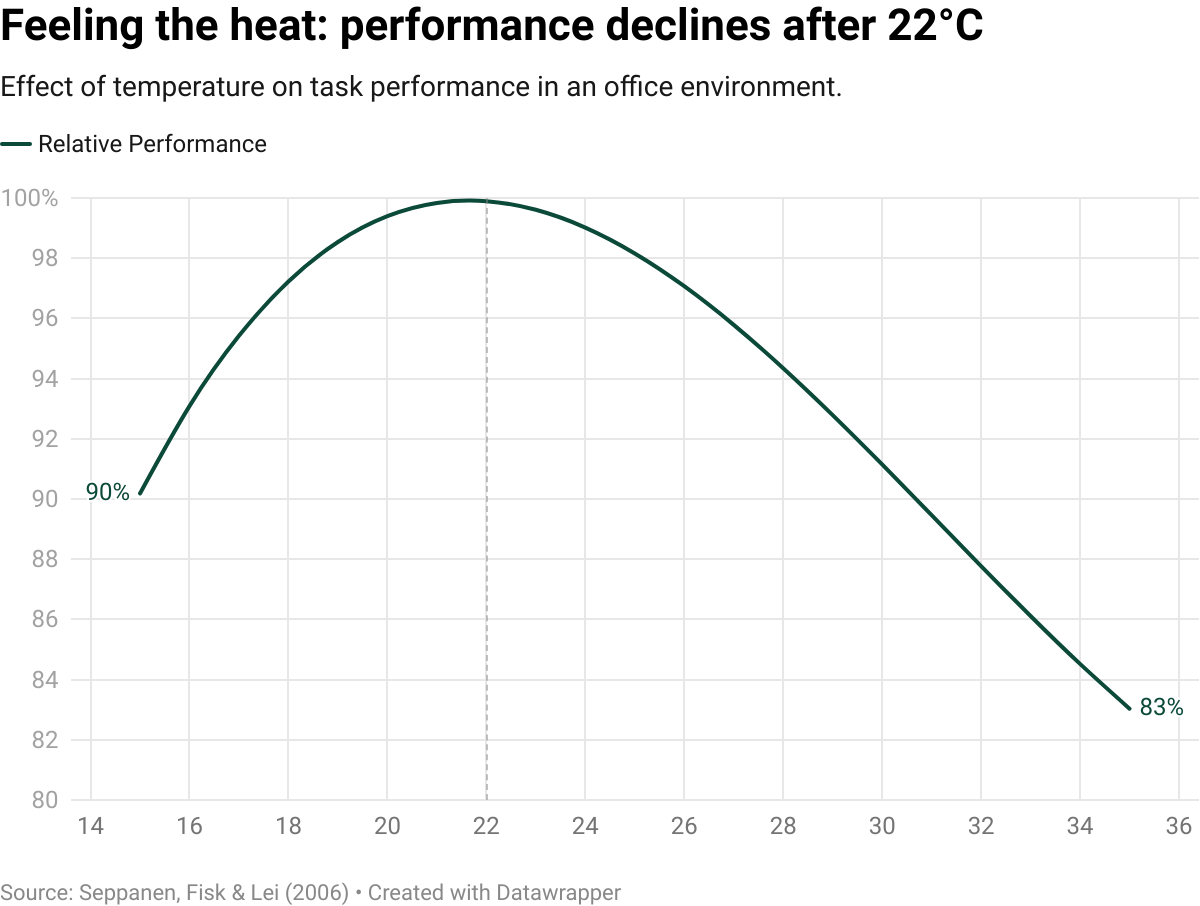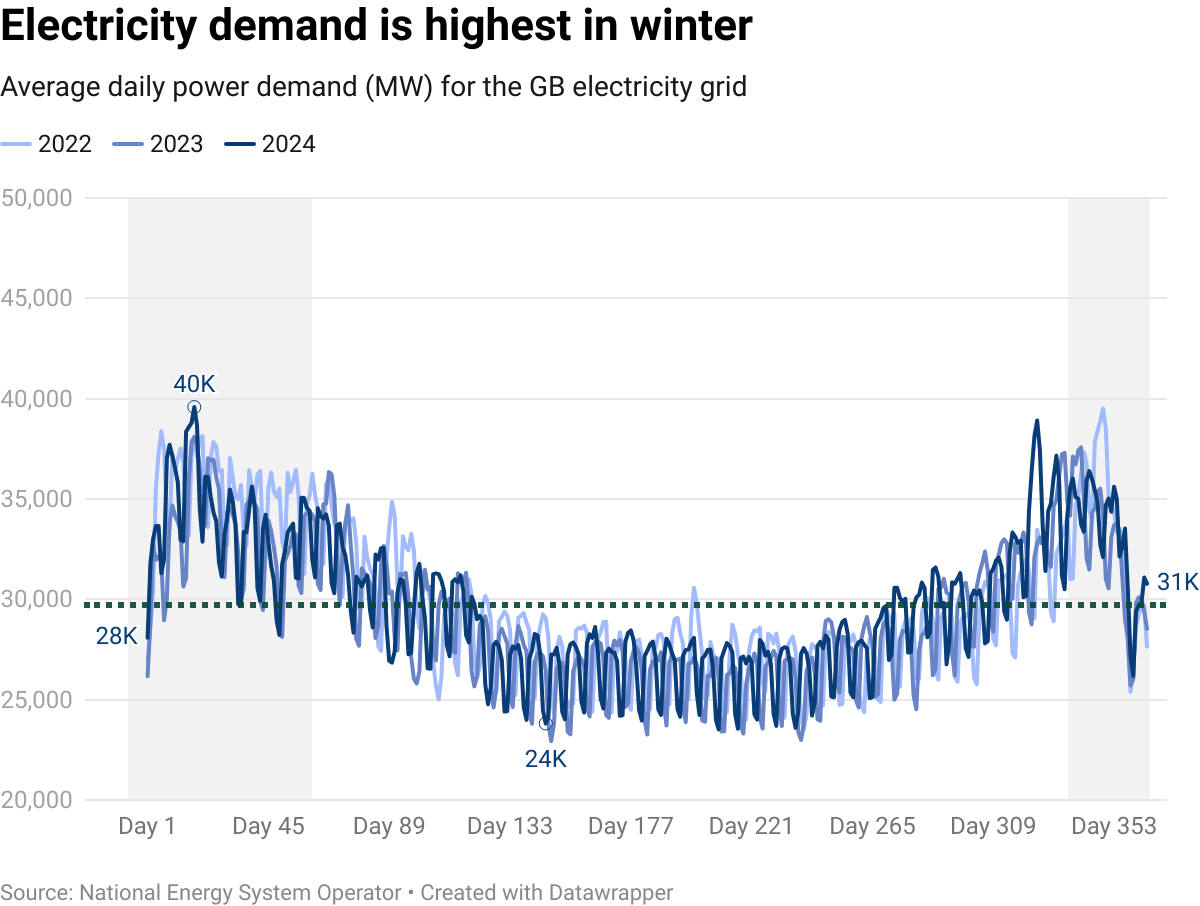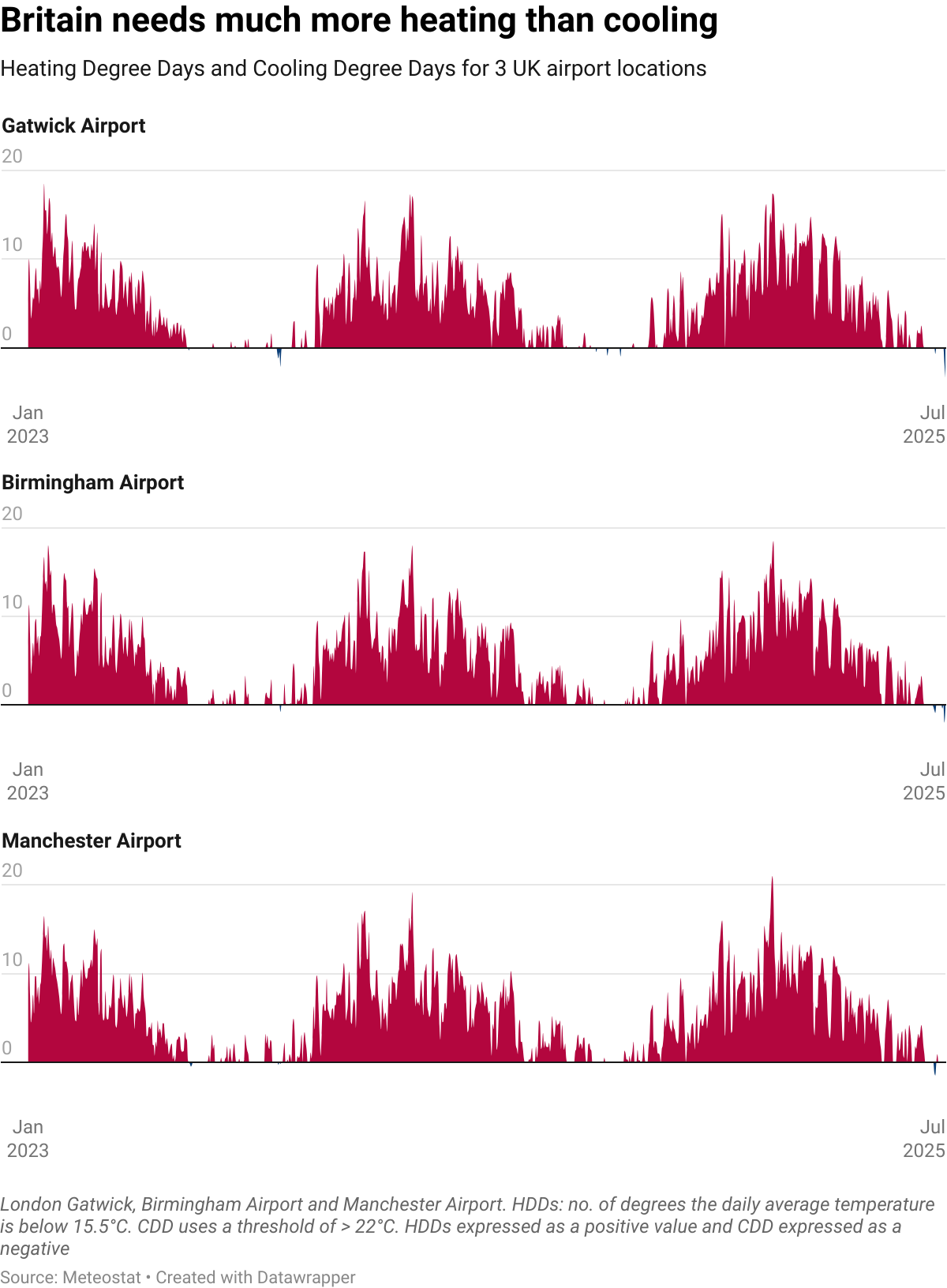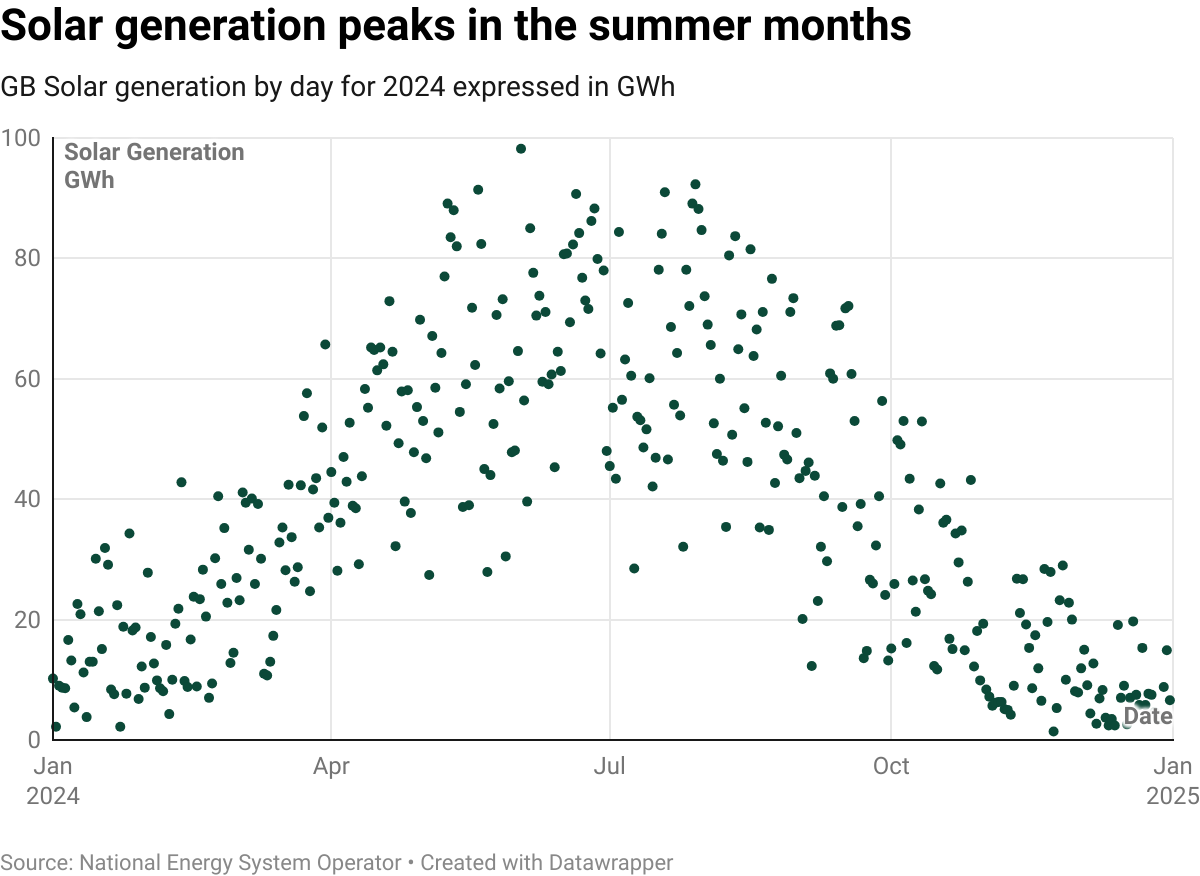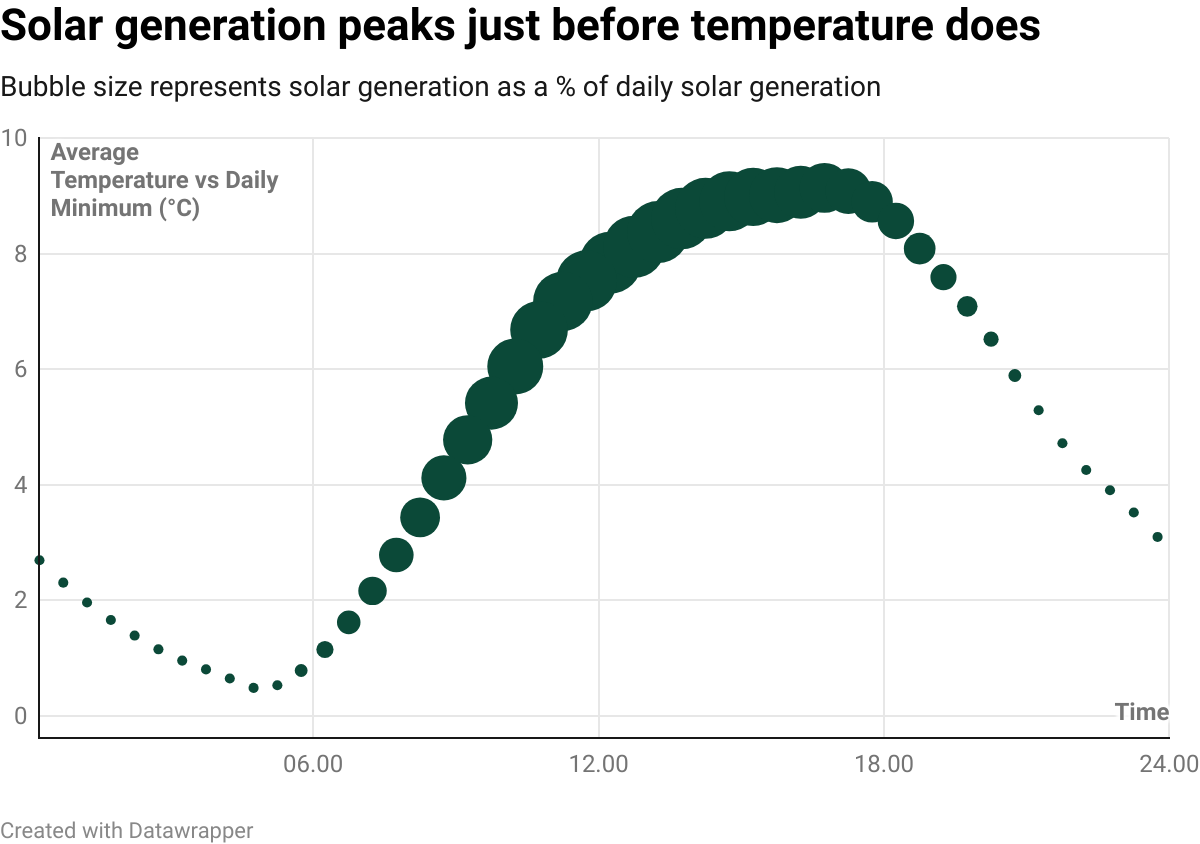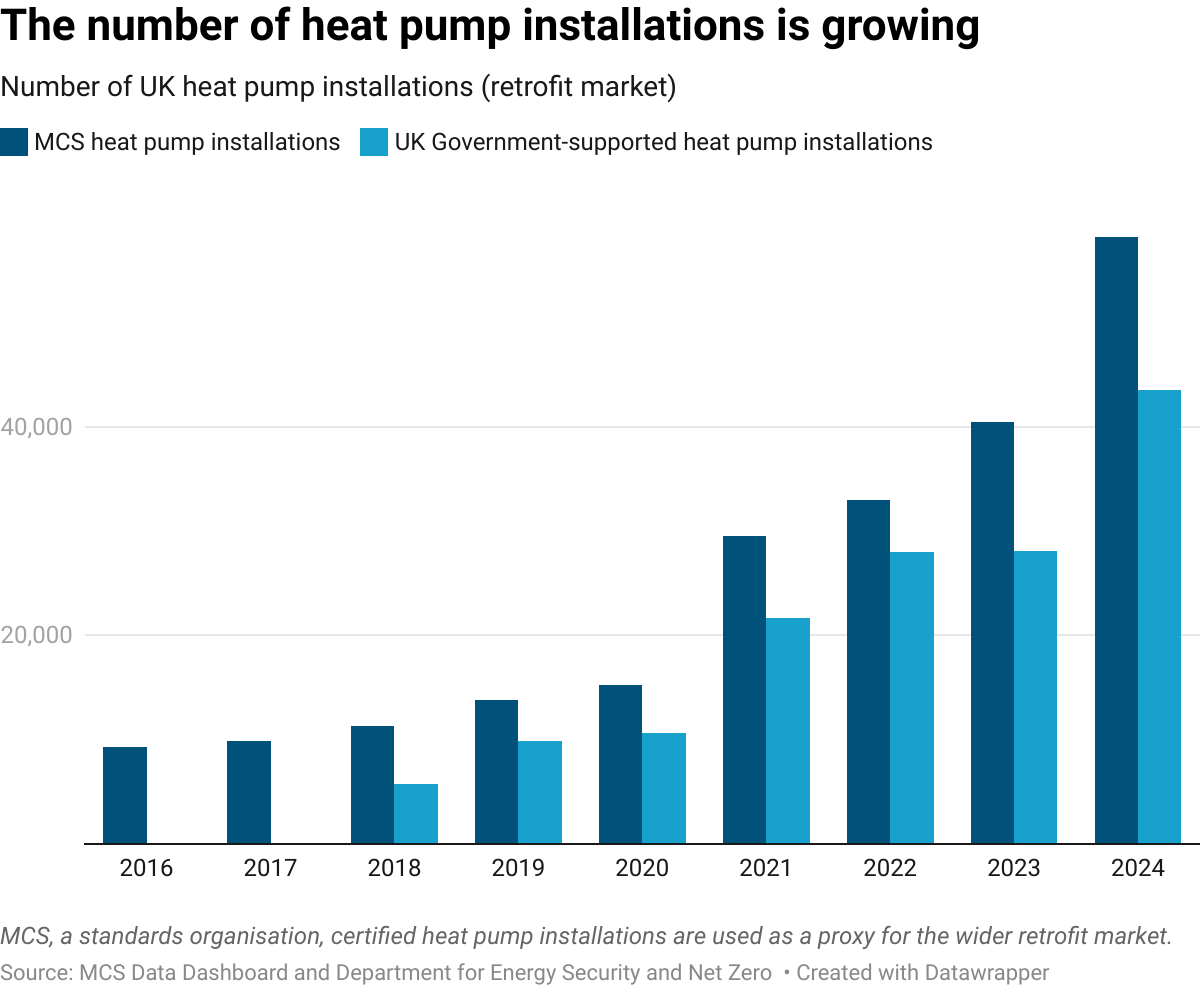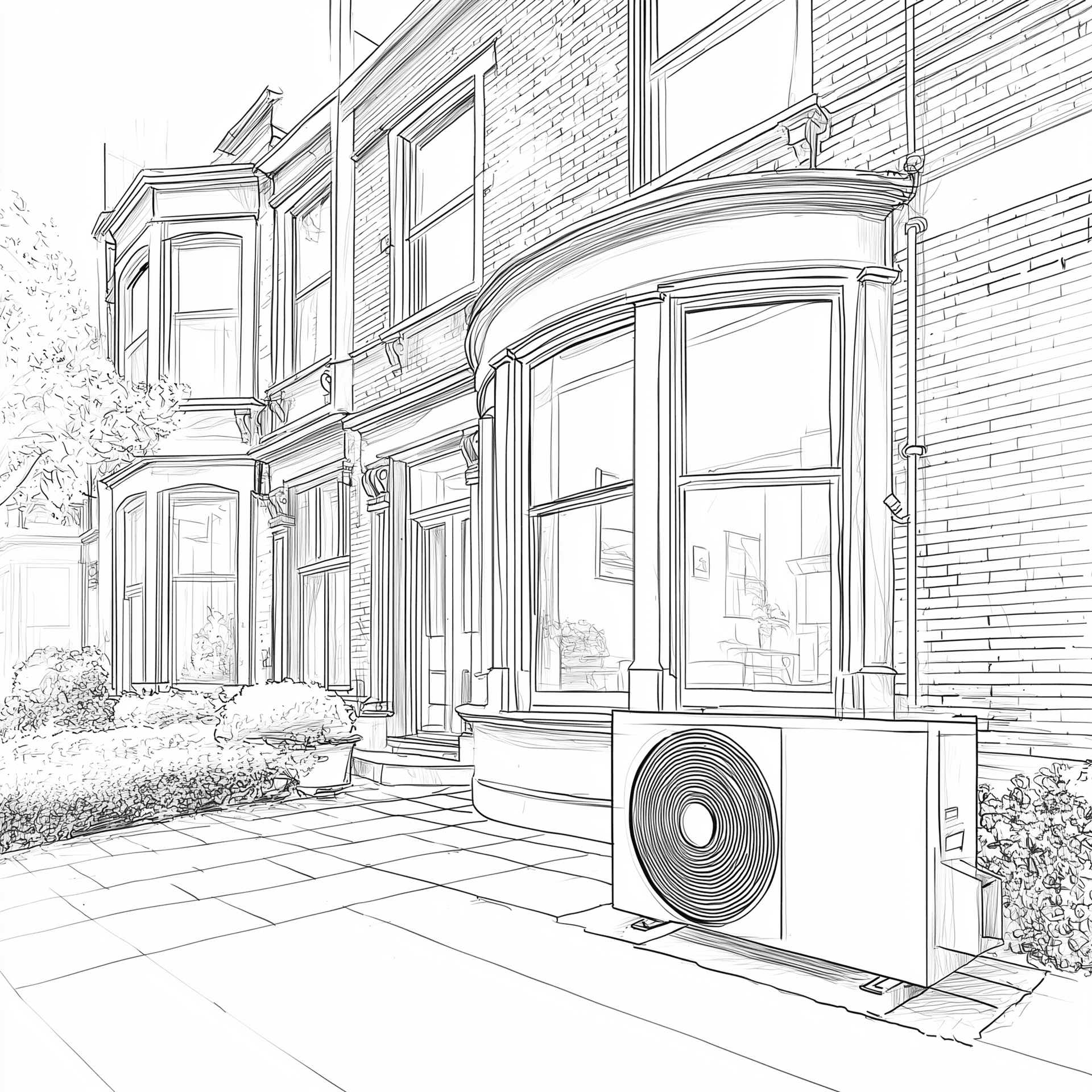
Table of Contents
- 1. Summary
- 2. Introduction
- 3. Why cooling matters
- 4. Confronting energy use
- 5. Air-to-air heat pumps
- 6. Rebalancing the rules to allow air conditioning
- 7. Authors
Summary
- Britain is getting hotter, but is poorly prepared for the heat. Only 5% of British households have air conditioning, compared to 37% of people worldwide. Half of all UK homes overheat during the summer months.
- Heat-related death rates in the UK in 2022 were over 10 times those in Sweden, and twice that of the (climatically-similar) Netherlands. London's rate of heat related deaths exceeded any other northern European capital city, and were similar to those in Rome.
- High temperatures are not only uncomfortable; they cost lives. In 2022, circa 3000 people in Britain died from heatwaves. Studies show air conditioning can cut heat related deaths by 75%. Heat related illness disproportionately affects the elderly and those with disabilities.
- High temperatures make workers less productive and students perform worse in exams during heatwaves.
- Despite these costs, government heat pump upgrade schemes exclude air-to-air devices whilst building regulations decree that air conditioning is only used when other measures are insufficient. This effectively bans air conditioning in new build homes. Similar restrictions are baked into London’s planning policies.
- Our analysis shows that UK electricity demand peaks in the winter months, and will continue to do so as heating is electrified. Adding air conditioning demand makes use of this spare grid capacity in summer.
- Air conditioning can help balance the grid and support the green transition, since its demand profile is well aligned with solar generation. Adoption is likely to increase solar energy demand and help speed up clean power. It may also help speed up clean heating adoption by giving homeowners a reason to upgrade.
- The impact of the modern British summer – on our health, welfare and productivity – is not inevitable, but the result of policy choices. This Government has the opportunity to make Britain a greener, healthier, and cooler place to work and thrive.
Introduction
Imagine that, one winter, the heating switched off in every home, school, and office across Britain. This would be a national catastrophe to rival Covid. Hospital waiting rooms would be filled with coughing, shivering pneumonia patients. We would crowd into shops, cafés, anywhere to keep warm. Churches and charities would hand out hot meals. There might be riots, certainly a national inquiry, and perhaps a snap election.
Being at a tolerable temperature is fundamental to human welfare. In the winter, we understand this and act accordingly. But in the summer, we ignore it. Although Britain is known more as a cold country than a hot one, for a few weeks of the year, it can be intolerably hot. Because of climate change, this will only get worse. London and the southeast of England, home to a third of the population, have a climate that is more like northern France than Northern Ireland.
Only 5% of British homes have air conditioning. Few schools have air conditioning, so children and teenagers sit exams each year in stifling heat. Public transport, particularly buses and metros, and many workplaces, can be sickeningly hot during heatwaves. The temperature on London’s Central Line has been known to surpass the legal limit for transporting cattle. All of this means that, for several weeks a year, a British summer can feel far less comfortable than those of many southern European countries, southern USA, or even east Asia.
Bringing physical comfort to millions of households, workers, and schoolchildren would be a laudable policy goal in itself. But few technologies hold as many widespread benefits as air conditioning. Cooler offices and schools are more productive: workers see a rise in productivity, and evidence shows that students perform worse in tests during heatwaves. Lee Kuan Yew, the ‘founding father’ of Singapore, believed that air conditioning was one of the most important inventions for economic development and civilisation, because of its impact on productivity, and he rolled it out across schools, offices, and government buildings.
Even more importantly, not having air conditioning can be deadly: in 2022, a hot year , saw circa 3000 excess deaths during heatwaves, due to heatstroke, dehydration, cardiovascular stress, kidney failure, respiratory issues, and exacerbation of existing illnesses. Temperatures above 28°C put stress on even the healthiest bodies, but for the elderly, disabled or vulnerable, anything over 25°C can add strain, with potentially deadly consequences.
Perhaps counterintuitively, air conditioning is also likely to be good for the UK’s green transition. This is because its demand profile is countercyclical to Britain’s existing energy use: we want air conditioning when it is hot, in the summer, when days are longer. These are not only periods of lower grid demand, but also periods of abundant solar generation.
Furthermore, one of the key constraints on increasing solar deployment in the UK is a lack of electricity demand when the sun is shining. Air conditioning use would make solar energy more economically viable, helping it contend with fossil fuel alternatives. Air conditioned public transport would make the greener option more attractive. Air-to-air heat pumps would allow households to electrify their heating and have cooler homes at the same time.
Despite all of these potential benefits, which grow in magnitude with every record-breakingly hot summer, Britain’s planning and regulatory systems all but ban air conditioning in many homes.
The boiler upgrade scheme, designed to encourage the electrification of household heating, nonsensically excludes air-to-air heat pumps, which can allow both heating and cooling. The same applies to the energy company obligation and clean heat market mechanism schemes.
Meanwhile, building regulations require that air conditioning is only used when other measures are insufficient – effectively banning air conditioning in new build homes. Similar restrictions are baked into London’s planning policies – despite the city experiencing the highest temperatures with the smallest, hottest homes.
Britain could be a cooler place to live. The first step is to realise this: we are now, on many measures, a hot country, and this has a very real impact on our health, productivity, welfare, electricity grid and climate ambitions.
The second step is to act accordingly: existing planning rules and regulations needlessly penalise air conditioning. Policymakers treat it as a luxury, perhaps fuelled by the false belief that it would add unsustainable pressure to the grid – when it could in fact speed up the clean power transition.
The journey of human progress can be mapped by ingenious methods we have devised to remain at comfortable temperatures, allowing us to do our best work, stay healthy, and flourish. Air conditioning is no new technology, but we need it now more than ever: it’s time we allowed the air to flow.
Why cooling matters
UK summers are getting hotter, particularly in the capital. In the 1990s and 2000s, prolonged periods of high temperatures were rare; in London only two years in a decade might have a 3 day period where temperatures breached 30°C. Today, stretches of multiple 30°+ days are common, happening nearly every year. 2025 has already had two such stretches – and there are probably more to come.
The world has warmed by about 1.5°C relative to the pre-industrial average, but Europe has warmed faster than any other continent. Temperatures in formerly temperate northern Europe are close to 2.5°C warmer than they were a century ago. By 2080, it is likely that average summer temperatures in southern England will be more than four degrees warmer than they were in 1960.
The same story can be seen in the number of extreme heatwaves. Seeing a 40° summer day in the UK is some 20 times more likely than it was sixty years ago, and within the next decade, it is possible that average daily highs could exceed 28°C for entire months in England.
Britain is not ready for these changes. Worldwide, about 37% of people have air conditioning, compared to only 5% of British households. Half of all UK homes overheat during the summer, and a 2024 study of British schools found that very few had air conditioning.
Most Brits rely instead on fans and passive cooling systems. This may be sufficient when external temperatures are in the low 20°s, but measures like improved ventilation won’t cut it during a prolonged heatwave. In a 2023 study, every single London home sampled exceeded 25° during the summer; 30% of homes had heat indexes over 32°C. Health authorities advise that in these temperatures, fans are insufficient.
Trying to live without air conditioning has consequences.
One of the most obvious consequences of high temperatures is lower productivity; it is miserable to work when it’s very hot. Someone working in a 30° office is circa 9% less productive than someone working at 22°. Since Covid, working from home has become more prevalent – meaning more work is being done outside of air conditioned environments.
Students are also affected by the heat; they learn less and are more likely to fail exams. The effects are stronger for students who may already be under strain: in the US, overheated schools disproportionately hurt the outcomes for traditionally disadvantaged students.
For some people, though, the heat is more than merely uncomfortable and unpleasant: it can be fatal. Every body is put under additional strain in the heat; high temperatures cause increased numbers of strokes, heart attacks, and even suicide attempts. 2022’s heat waves caused around 3000 excess deaths in the UK. By 2050, this number could reach 10,000 a year.
In 2022, the rate of heat-related deaths in the UK was over 10 times that of Sweden, and twice that of the (climatically-similar) Netherlands. London's rate of heat related deaths now exceeds any other northern European capital city, and is similar to that of much-warmer Rome and Valletta.
Perhaps unsurprisingly, the burden falls most heavily on the vulnerable. Low-income households are more than twice as likely to report overheating. Low-income households are also more likely to be elderly or disabled, and these groups also suffer the most severe health consequences from heat. Care home residents are at particular risk.
Much of this is preventable.
Using air conditioning can prevent about 75% of heat-related deaths. In a year like 2022, this could have saved some 2,200 lives.
Hot countries have long felt air conditioning was essential to survival and productivity. Singapore’s Lee Kwan Yew said that air conditioning is what “enabled Singapore’s success” – that without air conditioning, it was impossible to get any work done.
Researchers have found other negative effects from heat too. Violent crime rises. Maternity wards see more premature births. Although most modern offices are air-conditioned, the people who return to EPC-rated “A” and “B” homes often find those supposedly efficient, airtight dwellings trap heat worst of all. Hospitals feel the strain too: hotter wards and faltering equipment slow procedures and stretch NHS capacity just when demand for emergency care is spiking.
Confronting energy use
Much of the opposition to domestic air conditioning in the UK stems from concerns about its energy consumption. Given the UK’s aim to decarbonise its electricity system, there is no clear reason why using electricity to provide cooling in people’s homes is a bad thing.
However, with the current electricity generation mix, there are three potential concerns around increased air conditioning:
- Creating a new demand peak on the electricity grid could raise bills by imposing higher electricity system costs on other consumers, as more investment would be required for generation, transmission, and distribution.
- Creating an electricity demand profile that is hard to decarbonise would create more carbon emissions
- Widespread air conditioning use could contribute to the urban heat island effect, making temperatures higher for those outside
We believe these concerns can all be addressed, and examine each in turn.
Air conditioning – a new demand peak?
Existing seasonal demand
Great Britain’s electricity system is built for winter. Both average and peak daily demand are higher when it is colder and darker. Shorter days in winter mean we use more lighting, spend more time indoors, and, as a growing number of households use electric heating, this effect will only increase.
The GB electricity system is already built to handle the peak demands of winter – adding incremental air conditioning demand into the system won’t add to the existing infrastructure requirements and thus won’t add to system level costs.
Future seasonal demand
As the UK transitions to net zero, it will be essential to electrify transport and heating. Assuming that transportation requirements remain largely constant throughout the year, we should examine the impact of electrifying heating (and cooling) when assessing future seasonal demand.
Our chart below assumes that days averaging below 15.5°C require heating, and days above 22.0°C require cooling. Using average daily temperature data from three UK airport locations over the last two and a half years, it indicates the relative demand associated with electrified heating and cooling. Positive, red bars are heating days (peaking in the winter months), and cooling days are negative and blue.
It is difficult to see the cooling days for both Birmingham and Manchester, they are so massively outweighed by the demand for heating. In all three locations, both the amplitude and cumulative demand for heat clearly outweigh the need for cooling. Whilst global warming will likely make this demand profile more balanced in future, it is evident that the electrification of heating and cooling is likely to exacerbate the existing seasonality of electricity demand.
The main challenge confronting the UK is building a grid that can handle the peak loads associated with a cold winter's day. Rather than adding to overall demand, air conditioning in the summer months means the demand is spread out more evenly throughout the year, making investments in additional capacity more viable.
Air conditioning – hard to decarbonise?
If our electricity system is completely decarbonised, use of air conditioning shouldn’t increase carbon emissions. The UK government aims to largely decarbonise electricity generation, following the 2030 Clean Power Action Plan. The plan entails 95% decarbonisation of the electricity system by 2030, with circa 5% of electricity generation expected to come from unabated gas power stations.
Air conditioning use is only an issue if we continue to rely on fossil fuels for electricity generation, and if the demand profile of air conditioning – when we demand it – depends on periods where the electricity grid requires gas. Luckily, the days with the most solar power are the days we need cooling the most.
The annual generation profile of solar is unsurprisingly skewed towards the summer months.
We can see the correlation between solar generation and peak daily temperatures (in London) on the graph below.
Whilst the relationship isn’t perfect, there is a fairly strong positive correlation (R² of 0.49) The analysis was repeated for 2022 and 2023 with similar results. Days with a maximum temperature of 25.0°C or greater (shaded) are associated with high solar generation.
It is important to assess the time profile of solar generation versus the likely time demand associated with domestic air conditioning use. Taking average solar generation data across 48 half hourly settlement periods for the summer months of June–August 2024 reveals a solar generation profile that emerges at around 5:30am, peaks around 1pm and has all but disappeared by 8:30pm.
The solar generation profile is well matched to 9am–5pm working hours – making it very well placed to provide air conditioning in non-domestic buildings such as offices, shops and schools.
Whilst there is limited data available for domestic air conditioning use, the demand profile is likely to be shifted later in the day, an argument advanced by the BEIS 2021 paper “Cooling in the UK”, which states that:
“Most non-domestic buildings are occupied during the working day (8am to 6pm) so
their cooling profile peaks during this time. However, dwelling cooling demand tends to peak in the early evening when residents return home and cooling systems are switched on.”
As well as the behavioral driver of occupants returning to the domestic environment in the early evening, the temperature profile for London Weather Centre over the months of June–August 2024 reveals an external temperature peak at around 5pm, circa 4 hours after the peak in solar generation at 1pm.
There will also be instances where air conditioning demand continues into the night, especially on evenings when the outside air temperature is too high to reduce building temperatures to comfortable levels via ventilation alone.
Is this problem surmountable?
Fortunately there are many ways to try and better match the supply and demand profile:
- Pre-cooling strategies: Consumers could set thermostats to pre-cool the homes when electricity is cheaper, reducing the temperature before the evening peak
- Storage strategies: Grid scale battery or pumped hydro storage could help shift the supply peak to later in the day
- More nuclear: Greater nuclear capacity could provide clean power overnight
- Solar alignment: Solar farms could be configured to capture more evening sun, via technologies such as solar trackers
Regardless of the method chosen to help match supply and demand, it should be substantially easier to decarbonise the electricity demand for cooling than the equivalent for electrified heating.
Indeed, the UK’s Clean Power 2030 Action Plan aims to have 45-47 GW of solar capacity installed by 2030, approximately 2.5x current capacity. CFD contracts have clauses that protect consumers by not paying out when wholesale electricity prices turn negative – adding demand that can help make use of peak solar generation will be an important driver in helping realise the Government's solar capacity ambitions.
The urban heat island effect
The final concern about air conditioning use is its contribution to the urban heat island effect – where temperatures in densely populated areas become substantially warmer than rural surroundings. Air conditioning can contribute to this effect, by discharging heat from homes into the urban environment, in turn driving more demand for air conditioning.
A 2014 study by a team of researchers at Arizona State University estimated that air conditioning use in Phoenix could increase night time temperatures by 1-1.5℃ during heat wave conditions, with much lower impacts during the day.
While the UK isn't Phoenix, this would require careful policy consideration – strategies might include increasing the number of trees in urban environments, or encouraging consumers to invest in technologies that can recover some of the exhausted heat for use in hot water tanks or via thermal batteries.
Air-to-air heat pumps
Carbon emissions associated with domestic heating make up circa 14% of the UK’s total. There is a neat opportunity to drive decarbonisation of our existing housing stock by allowing consumers to cool their homes via air-to-air heat pumps.
Heat pump technology is the government's preferred solution to decarbonise domestic heating. Heat pumps run on electricity, making them much easier to decarbonise than gas boilers. They are also much more efficient than resistive electric heating systems, such as electric storage radiators.
An air source heat pump (the most common type) has a few key elements:
- An outdoor unit contains a refrigerant inside an evaporator coil. When outside air is fanned over the coil, the refrigerant absorbs heat energy and evaporates from a liquid into a gas
- The gaseous refrigerant moves through a compressor, increasing the pressure and temperature
- The warm, gaseous refrigerant passes over a heat exchange surface, transferring the heat energy from the refrigerant into a new medium – typically the water in domestic radiators or a hot water tank (referred to as a ‘wet’ or ‘hydronic’ heating system)
- The now cooled refrigerant passes through an expansion valve, reducing its pressure and temperature, returning to the start of the process.
Air source heat pumps can be grouped into two types – when they are used to heat the water in radiator systems, they are referred to as “air-to-water” heat pumps. However, they can also be used to deliver heating (or cooling) directly via hot or cool air – an “air-to-air” heat pump.
The Future Homes Standard is expected to accelerate heat pump uptake in the new build market by effectively banning gas boilers in new build homes. However, heat pump uptake in existing homes has been sluggish. Whilst the trend has been improving, 40,000-50,000 installations per year is a drop in the ocean compared to circa 23 million UK homes with gas boilers.
There are plenty of reasons why consumers might be reluctant to switch their gas boiler to an air source heat pump.
- Installation costs are much more expensive than a replacement boiler – a gas boiler replacement might cost circa £3250 vs. £13,000 for an air source heat pump (or circa £6,500 post a £7,500 grant)
- The UK has unusually high electricity prices relative to gas, increasing running costs
- Heat pumps require a hot water tank, taking up more space than a combi boiler
- The external heat pump unit outside the property further increases space requirements
- The gradual form of heating associated with heat pumps is unpopular with some consumers
The list of positives is brief. Whilst the carbon savings are significant, to save money on a running cost basis, consumers need to have a well installed heat pump and ideally couple that with a time of use heating tariff. It is unrealistic to expect every UK consumer to devote a huge amount of headspace to emulating the best performers at the “Top of the SCOP’s” leaderboard at HeatpumpMonitor.org
Finding an extra £3,250, as well as space for a hot water tank and outdoor unit at a time of acute stress (boiler breakdown) is unlikely to get too many takers.
Is air conditioning the missing trick?
Air conditioning units are effectively simple heat pumps that operate in a single direction, taking heat energy from inside a building and transferring it outside. You can think of an air source heat pump as a fancy air conditioning unit that can supply both heating and cooling, thanks to the presence of a reversing valve.
The vast majority of UK homes are heated via ‘wet’ or ‘hydronic’ heating systems – in that a gas boiler (or heat pump) is used to heat up the water circulating within a domestic radiator system. The majority of UK heat pump installations follow this logic, with the heat pump transferring heat energy to the water based radiator or underfloor heating system. Running these systems in cooling mode can come with several issues:
- Radiators can have problems with condensation when running at low temperatures
- Radiators aren't designed to transfer cold temperatures – as they rely on convection and radiation to keep homes warm
If an air-to-air heat pump is used to heat or cool the air directly, rather than a water based radiator system, these issues are surmounted.
The typical air-to-air heat pump configuration is a ‘split’ or ‘multi-split’ system, where the outdoor unit is connected to one or more indoor air blowing units, normally installed high up on the walls of rooms that require heating. The outdoor and indoor unit(s) are connected by refrigerant lines.
Advantages | Disadvantages |
Much lower capital costs – due to lower spend on pipework and radiator upgrades. Air-to-air could be 1/5th of the up-front cost relative to air-to-water | Hot water – most air-to-air systems don't incorporate hot water heating, though some manufacturers are now offering this capability |
Additional features – such as cooling, air filtration and humidity control offer not only increased comfort, but also the ability to combat damp and mould | Noise – indoor units are noisier than near silent radiator systems |
High efficiency for both heating and cooling and control over individual room temperature | Refrigerant – greater volumes of refrigerant are needed due to refrigerant lines connecting the units |
Room space can be recovered via radiator removal | Air based heating systems may be less popular with consumers |
Large existing installer base of UK F-gas registered engineers due to commercial air conditioning (50,000 qualified installers for air-to-air heat pumps vs. circa 7,000 for air-to-water) | |
Especially well suited for homes without an existing hydronic heating system (circa 11% of UK homes) |
The additional benefit of dehumidification functionality is particularly relevant to the UK’s existing housing stock. The most recent English Housing Survey estimates that 1.3 million homes had a problem with damp – air-to-air heat pumps operating in dehumidification mode could prove a useful tool to reduce damp and mould. Through this lens, air conditioning becomes an important part of the preventative public health infrastructure, rather than a luxury good.
Air-to-air heat pumps aren’t necessarily superior or inferior to air-to-water systems, but they do have different features which may suit different customer groups – e.g. those in buildings exposed to overheating risks (e.g. London flats) or those looking for a lower cost and less disruptive installation process. Consumers should be free to choose.
Data from other European countries suggests that there would be demand for air-to-air heat pumps. They were the best selling heat pump category across Europe from 2018-2022. It is difficult to know how UK consumers might react to the proposition – but our current system of exclusionary grant mechanisms and anti cooling building regulations make it hard to find out.
Rebalancing the rules to allow air conditioning
UK regulation creates significant barriers to the installation of air conditioning, both for new build homes and retrofit. The table below summarises the key restrictions, which can be grouped into two types:
- Government grants / upgrade schemes where air-to-air heat pumps are excluded
- Building and planning regulations that heavily discourage air conditioning
Scheme | Description | Barrier |
Boiler Upgrade Scheme (BUS) | A grant to cover the cost of replacing fossil fuel heating systems – typically £7,500 for a heat pump | Air-to-air heat pumps are ineligible as the medium of heat delivery must be a liquid |
Energy Company Obligation (ECO) | Scheme where medium/large energy suppliers must promote measures to help low income households heat their homes | Only hydronic heat pumps can be funded through the ECO4 scheme (air-to-air not eligible) |
Clean Heat Market Mechanism (CHMM) | Obligation for gas/oil boiler manufacturers to meet targets for heat pump installation – either via self supply or credits from other manufacturers | Air-to-air heat pumps are excluded – hydronic systems only |
Part O Building Regulations | Regulations on overheating mitigation for new residential buildings | Drafted to ensure that mechanical cooling is only used when other measures are insufficient |
The London Plan Policy 5.9 – Overheating and cooling | London specific overheating rules | During the planning permission process, major projects are guided to reduce reliance on air conditioning systems, using them as a last resort to deal with overheating |
To fix this the Government must take a number of steps. First, they should take a more technologically neutral approach to the types of heat pumps that receive regulatory support. Specifically:
- Boiler Upgrade Scheme: The Department for Energy Security and Net Zero has recently consulted on changes to the BUS, including the treatment of air-to-air heat pumps. Grant support should be advanced to air-to-air heat pumps in keeping with a more technological neutral choice architecture.
- Energy Company Obligation: Air-to-air heat pump installations should be eligible when installed as a main heating system
- Clean Heat Market Mechanism: Air-to-air heat pump installations should qualify for credits, when installed as a main heating system
Secondly, policies which prevent or discourage the inclusion of air conditioning in new build properties should be revised to avoid restricting active cooling measures, which are uniquely well placed to deal with periods of sustained high temperatures.
- Part O is designed to protect people from overheating. It fails in this regard by stigmatising air conditioning. We propose a simpler and more robust standard that focuses on protecting vulnerable people in the summer months. Buildings should be designed to ensure they remain sufficiently cool to be safe for vulnerable residents during the hottest parts of the summer. The new Part O should make clear that this can include the use of air conditioning.
- Local restrictions on air conditioning through planning rules, like the London Plan Policy 5.9 should be preempted through a National Development Management Policy which ensures that new homes may use active cooling methods to keep homes at a comfortable temperature in the summer months.
Together these reforms would increase consumer choice in the heat pump market and ensure that new build homes will be fit for Britain’s warming climate. If we want consumers to electrify their homes, we need to make the green option the most attractive choice. That means making sure that consumers feel the benefits. Encouraging electrified heating systems that can both heat and cool our homes will allow the UK to protect the vulnerable from extreme temperatures whilst accelerating the move to net zero.
For more information about our initiative, partnerships, or support, get in touch with us at:
[email protected]For more information about our initiative, partnerships, or support, get in touch with us at:
[email protected]